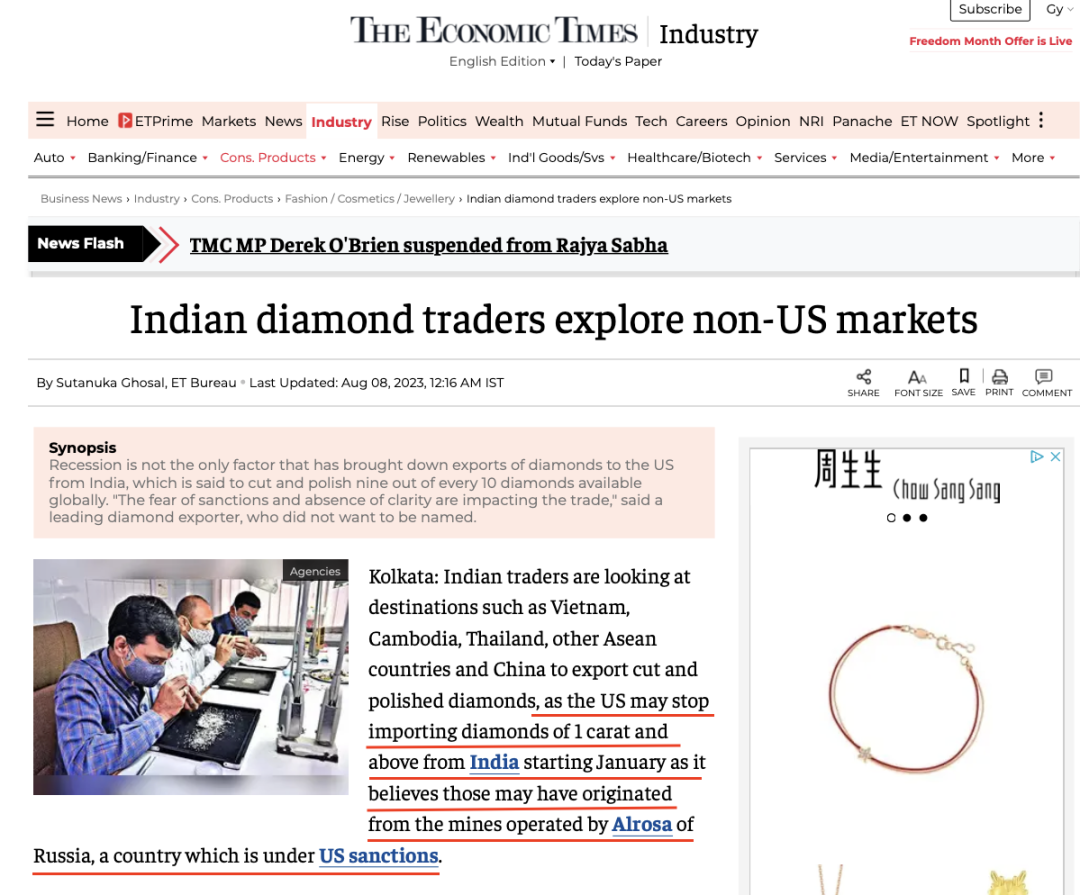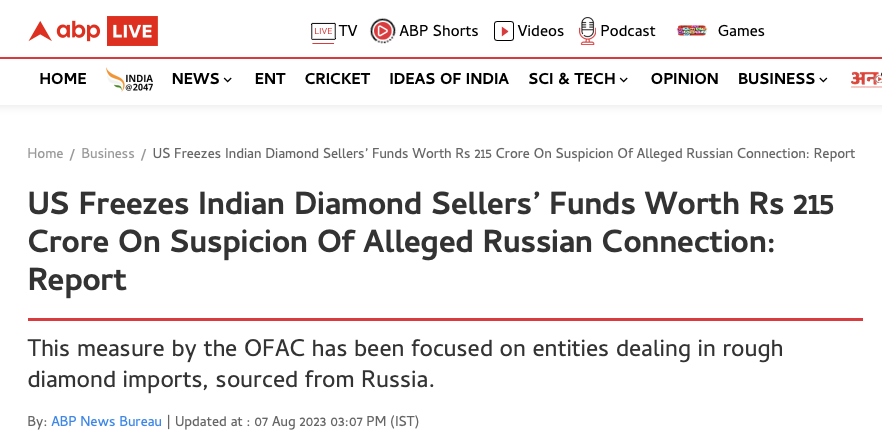Starting from January next year, the United States may stop importing more than 1 carat of (natural) bare diamonds from India - as long as the United States believes that these diamonds can be sourced from diamond mines operated by the Alrosa company in Russia.
The screenshot of the report is as follows:

Please note that our understanding of the two 'as' in underlined sentences is different: the first one is understood as' because', which is a causal relationship; The second one is understood as "as long as", which means it has a certain degree of conditionality.
The article suggests that the relevant restrictions may be issued in September this year. VIP Shah, the chairman of GJEPC, has already started negotiations with G7 and the United States. However, he also stated that he is "preparing to enter a new market".
Our main buyer - the demand from the United States is currently declining, and the diamond industry needs to survive, so we plan to penetrate other countries
In addition to China, there are also Vietnam, Cambodia, Thailand, and so on among the "other countries" mentioned here.
We take a wait-and-see attitude towards the statement that the United States has stopped importing more than 1 carat of natural bare diamonds from India, and we cannot rule out the possibility that this is an exaggerated promotion by the Indian media. After all, there have been reports that at least 50% of the bare diamonds in the US market are produced in India (unconfirmed, cautious reference). Although products with a weight of less than 1 carat account for the majority, the quantity of bare diamonds with a weight of 1 carat or more used in the wedding jewelry industry is still large. If we really stop importing more than 1 carat of bare diamonds from India next year, what will happen to the US market?
In addition, the question of whether the United States and G7 can truly eliminate the circulation of Russian diamonds in the Western market is actually very subtle. This not only involves the technical bottleneck of diamond tracing, but also involves multiple interest disputes and dark box operations. In terms of current traceability technology and supply chain characteristics, it is almost impossible to completely exclude Russian diamonds.
However, the United States is indeed making increasing efforts to sanction Russia (and its diamonds). On July 20th, Pavel Marinychev, the new CEO of Alrosa, was included in a new round of sanctions by the United States, and OFAC (Office of Overseas Asset Control) froze cross-border company transfers of a group of Indian jewelers (totaling around $26 million) a few days ago, as these companies were believed to have supply and sales relations with Russia. (The screenshot of the news is as follows)

Everything seems to be pointing towards two trends:
1) The natural diamond industry is becoming increasingly 'politicized', and signs of global supply chain fragmentation are becoming increasingly evident.
2) At the same time as demand has declined, the supply of natural diamonds has decreased due to human intervention (especially some of the bare diamond products).
This operation is naturally beneficial for the "scarcity" marketing of natural diamonds - at least in the Western world. After all, for buyers, what they want to buy but cannot buy is "scarce" - few people really delve into the reasons behind it.
But at the same time, this tactic may also force India to develop in another direction: reducing the production of natural diamonds and increasing the tilt towards cultivating diamonds.
For midstream countries, 'having raw materials',' having work to do ', and' being able to maintain factories and workers' are the basic needs. As for whether the grinding is natural or cultivated, it can be coordinated according to the market and policies.
In addition, India is also vigorously expanding production and cultivating diamond blanks, and its ambition to become the world's number one is constantly driving the industry's emotions. The cultivation of diamond blanks produced in large quantities naturally prioritizes receiving them from one's own cutting and grinding plant.
Therefore, the above factors indicate that there is a high probability that India's processing industry will continue to tilt towards cultivating the diamond sector in the future.
